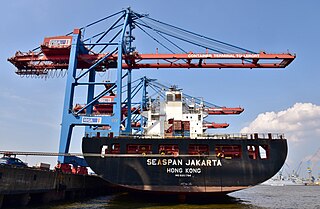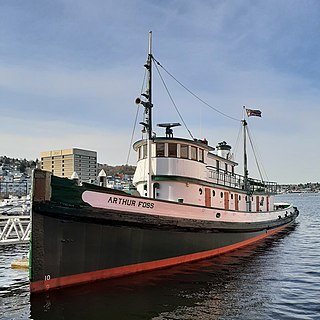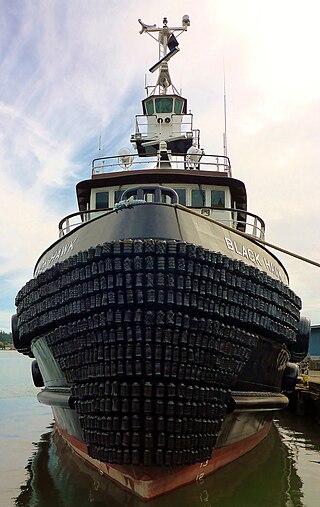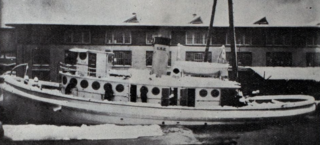
USS Zuni (AT/ATF-95), a Cherokee-class fleet tugboat, formerly called Navajo class, was a ship of the United States Navy named for the Zuni, the popular name given to a tribe of Pueblo Indians indigenous to the area around the Zuni River in central New Mexico near the Arizona state line.

Seaspan ULC provides marine-related services to the Pacific Northwest. Within the Group are three (3) shipyards, an intermodal ferry and car float business, along with a tug and barge transportation company that serves both domestic and international markets. Seaspan, is part of the Washington Companies that are owned by Dennis Washington. Kyle Washington, is the Executive Chairman of Seaspan, who has become a Canadian citizen.

Arthur Foss, built in 1889 as Wallowa at Portland, Oregon, is likely the oldest wooden tugboat afloat in the world. Its 79-year commercial service life began with towing sailing ships over the Columbia River bar, and ended with hauling bundled log rafts on the Strait of Juan de Fuca in 1968. Northwest Seaport now preserves the tug as a museum ship in Seattle, Washington.
Allied Shipbuilders Ltd is a privately held shipbuilding and ship repairing company established in Canada in 1948.

A crane vessel, crane ship, crane barge, or floating crane is a ship with a crane specialized in lifting heavy loads, typically exceeding 1,500 t for modern ships. The largest crane vessels are used for offshore construction.

M. D. Moody & Sons, Inc. was an American privately owned construction equipment distributor and heavy machinery service company headquartered in Jacksonville, Florida. The firm was established in 1913 by Maxey Dell Moody who wanted to serve the needs of road construction businesses by distributing construction equipment. In 1946 the firm was incorporated to M. D. Moody & Sons, Inc. and by 1980 under Maxey Dell Moody, Jr. diversified into the Moody companies Moody Truck Center, Moody Light Equipment Rental, Moody Machinery Corporation, Moody Fabrication & Machine, Dell Marine, and MOBRO Marine, Inc. In 2009 M. D. Moody was forced to file for Chapter 11, Title 11, United States Code bankruptcy and became defunct in 2013. As of 2020 the three Moody companies still in operation are MOBRO Marine, Inc., Dell Marine and Dell Marine Tug and Barge.
The Santa Fe Railroad tugboats were used by the Atchison, Topeka and Santa Fe Railway to barge rail cars across the San Francisco Bay for much of the 20th century, as there is no direct rail link to the San Francisco peninsula. In the post World War II period, a fleet of three tugs moved the barges: the Paul P. Hastings, the Edward J. Engel, and the John R. Hayden. After cross-bay float service had ended and the tugs had been sold, the Hastings sank off Point Arena, California in 1992, in water too deep to raise. The Engel sank off Alameda, California in 2007 and was raised and scrapped in the winter of 2013-14. The Hayden remains afloat and in service in Oregon.
Risdon Archibald Beazley (1904–1979) was the founder of Risdon Beazley Ltd, a Marine salvage company that operated from 1926 to 1981 in Southampton, England.

Heerema Marine Contractors (HMC) is a contractor headquartered in the Netherlands most notable for operation of three of the largest crane vessels in the offshore industry.

USNS Powhatan (T-ATF-166) was the lead ship of the United States Navy Powhatan-class fleet ocean tugboats. She was in service with the U.S. Navy from 1979 to 1999, and then was leased to a private towing and salvage company. At the end of the lease in 2008, the ship was sold to the Turkish Navy which recommissioned her as TCG Inebolu.
Shark River Reef is an artificial reef located in the Atlantic Ocean, 15.6 miles southeast of Manasquan Inlet, off of the coast of Ocean County, New Jersey. The site contains almost 4 million cubic yards of dredge rock material. Although 96% of the total reef material is rock, the site also contains numerous subway cars.

General Miles was a steamship constructed in 1882 which served in various coastal areas of the states of Oregon and Washington, as well as British Columbia and the territory of Alaska. It was apparently named after US General Nelson A. Miles.

The SS St. Marys Challenger is a freight-carrying vessel operating on the North American Great Lakes built in 1906. Originally an ore boat, she spent most of her career as a cement carrier when much larger ore boats became common. After a 107-year-long working career as a self-propelled boat, she was converted into a barge and paired with the tug Prentiss Brown as an articulated tug-barge. Before conversion, she was the oldest operating self-propelled lake freighter on the Great Lakes, as well as being one of the last freight-carrying vessels on the Great Lakes to be powered by steam engines.

Sause Bros., Inc., a pioneering Oregon ocean towing company founded in 1936, is a privately held, fourth-generation family company serving routes along the West Coast of the United States, Hawaii and other islands of the South Pacific, as well as Alaska. It maintains a sixty-vessel fleet of tugboats and barges, employing approximately 400 people at its facilities in Coos Bay, Portland, and Rainier, Oregon; in Long Beach, California; and in Honolulu and Kalaeloa, Hawaii.

Weeks 533 is a 500-short-ton (454 t) capacity Clyde Iron Works model 52 barge-mounted crane which is the largest revolving floating crane on the East Coast of the United States. It was originally ordered for bridge construction and has since been used in several notable heavy lifts.

Maxey Dell "Max" Moody III, also known as M. D. Moody III, is the former CEO of M. D. Moody & Sons, Inc. and the former President of MOBRO Marine, Inc. Max also founded Dell Marine, Moody Fabrication & Machine, Inc., and co-founded the incorporation of Moody Brothers of Jacksonville to MOBRO Marine, Inc.
Tagiuk Provider, formerly Arctic Endeavor, is a 205 ft (62 m) 1500-ton ice-class flat-topped deck cargo barge adapted to being a clam-shell crane scoop mining platform for placer gold mining in the Bering Sea off Nome, Alaska, United States. The barge, a gold dredge, is owned by Tagiuk Gold, which previously ran scuba-diver-operated suction dredges for seafloor gold mining in the area. Tagiuk Gold is run by miner Andrew Lee, whose business running the barge is partially crowdfunded. Tagiuk Provider was profiled in an episode of Bering Sea Gold, at which time, it was the largest scoop dredge operating off Nome.

Essayons was a tugboat of the United States Army Corps of Engineers. Her mission with the Corps was to support the installation of breakwaters and piers, and the dredging of harbors on Lake Superior. She was built in 1908 and served with the Army until 1949, when she was sold to the Zenith Dredge Company. Essayons continued her support of port construction and maintenance under her new owner until the mid 1960s. In 1994 she was sold again, this time to a local businessman, who hoped to convert her into a floating Bed and Breakfast. This plan never came to fruition and she sank at her moorings in Duluth Harbor in 2009.













